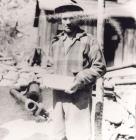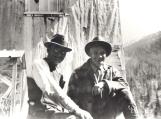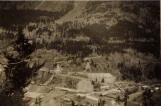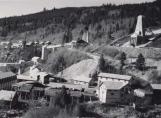1
Early claims on Pioneer were staked by Harry Atwood and William Allen in 1897. Shortly thereafter, F. Kinder acquired a 50 percent share by promising to purchase and operate a stamp mill, which proved only capable of crushing 100 lbs. of ore per day. Atwood and Allen withdrew from the partnership leaving Kinder to operate on his own for the next six years until he sold to a syndicate for $20,000. In 1915, Pioneer Gold Mines Limited was incorporated. Through the next nine years, the property was producing but it was examined and turned down by numerous companies who didn't have faith in it's potential.3
David Sloan's contribution to the Pioneer Mine operations began after production was suspended for lack of funds in 1924. He acquired 50% interest, and J.I. Babe the other 50%. In 1927, Col. Victor Spencer bought Babe's interest and together, they began what was to become the success story of the Pioneer Mine.4
Sponge gold before final process of heating off silver and pouring remaining melted gold.1929
Outside of Mill Building, Pioneer, B.C. Canada

5
Sponge gold and minor silver material has had the mercury driven off and is now ready for fire and cast to mold.7
In 1928 Pioneer Mine was incorporated with Col. Spencer as President, A.E. Bull as Secretary Treasurer, David Sloan as Managing Director and Harry Cain as General Manager.9
This was the start of the second shaft being sunk and the cyanide mill being built. Now the community of Pioneer was shaping up with the opening of the first school.10
The powerhouse on the Cadwallader Creek1927
Cadwallader Creek, below Bralorne at the confluence of the Cadwallader and Hurley rivers




